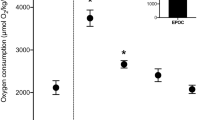Summary
Heart rate and pulmonary artery blood flow of resting green turtles,Chelonia mydas, at 29°C increased with lung ventilation (heart rate from 24±5 to 51±8 beats min). When swimming at 0.6 m s−1 in water at 30°C, oxygen uptake was 2.83 times and respiratory frequency was 2.75 times the resting values. Heart rate was 1.33 times that during ventilation at rest but 2.83 times that at the end of a breath hold at rest. Partial pressures of oxygen and carbon dioxide, lactic acid concentration and pH of arterial blood, when swimming at 0.5 m s−1, were similar to those soon after ventilation at rest. Pulmonary blood flow did not decline to low levels between breaths, when the animals were swimming, as it did when they were at rest.
In active turtles it appears that pulmonary perfusion remains elevated, supplying oxygen to the locomotory muscles at a sufficiently high rate to support the complete aerobic production of energy, and that respiratory frequency is kept as low as possible, as surfacing for air increases the metabolic cost of swimming.
Similar content being viewed by others
References
Bailey NTJ (1959) Statistical methods in biology. The English Universities Press, London
Bennett AF, Dawson WR (1976) Metabolism. In: Gans C, Dawson WR (eds) Biology of the Reptilia, vol 5. Academic Press, New York, pp 127–223
Berkson H (1966) Physiological adjustments to prolonged diving in the Pacific green turtle (Chelonia mydas agassizii). Comp Biochem Physiol 18:101–119
Brett SS, Shelton G (1979) Ventilatory mechanisms of the emphibian,Xenopus laevis: the role of the buccal force pump. J Exp Biol 80:251–269
Burggren WW (1975) A quantitative analysis of ventilation tachycardia and its control in two chelonians,Pseudemys scripta andTestudo graeca. J Exp Biol 63:367–380
Burggren WW, Shelton G (1979) Gas exchange and transport during intermittent breathing in chelonian reptiles. J Exp Biol 82:75–92
Butler PJ, Woakes AJ (1982) Telemetry of physiological variables from diving and flying birds. Symp Zool Soc (Lond) 49:107–128
Carr AF, Goodman D (1970) Ecologic implications of size and growth inChelonia. Copeia 1970:783–786
Farber J, Rahn H (1970) Gas exchange between air and water and the ventilation pattern in the electric eel. Respir Physiol 9:151–161
Gleeson TT (1980) Lactic acid production during field activity in the Galapagos marine iguana,Amblyrhynchos cristatus. Physiol Zool 53:157–162
Gleeson TT, Mitchell GS, Bennett AF (1980) Cardiovascular responses to graded activity in the lizardsVaranus andlguana. Am J Physiol 239:R174–179
Jackson DC, Prange HD (1979) Ventilation and gas exchange during rest and exercise in adult green sea turles. J Comp Physiol 134:315–319
Jackson DC, Kraus DR, Prange HD (1979) Ventilatory response of inspired CO2 in the sea turtle: effects of body size and temperature. Respir Physiol 38:71–81
Johansen K, Lenfant C, Hanson D (1970) Phylogenetic development of pulmonary circulation. Fed Proc 29:1135–1140
Kraus DR, Jackson DC (1980) Temperature effects on ventilation and acid-base balance of the green turtle. Am J Physiol 239:R254–258
Lenfant C, Johansen K, Peterson JA, Schmidt-Nielsen K (1970) Respiration in the fresh water turtle,Chelys fimbriata. Respir Physiol 8:261–275
Olsen CR, Hale FC, Elsner R (1969) Mechanics of ventilation in the pilot whale. Respir Physiol 7:137–149
Prange HD (1976) Energetics of swimming of a sea turtle. J Exp Biol 64:1–12
Prange HD, Jackson DC (1976) Ventilation, gas exchange and metabolic scaling of a sea turtle. Respir Physiol 27:369–377
Shelton G (1976) Gas exchange, pulmonary blood supply, and the partially divided amphibian heart. In: Spencer Davies P (ed) Perspectives in experimental biology, vol 1. Pergamon Press, Oxford, pp 247–259
Shelton G, Burggren W (1976) Cardiovascular dynamics of the Chelonia during apnoea and lung ventilation. J Exp Biol 64:323–343
Spencer MP, Gornall TA, Poulter TC (1967) Respiratory and cardiac activity of killer whales. J Appl Physiol 22:974–981
White FN (1976) Circulation. In: Gans C, Dawson WR (eds) Biology of the Reptilia, vol 5. Academic Press, New York, pp 275–334
Woakes AJ (1980) Biotelemetry and its application to the study of avian physiology. Ph D thesis, University of Birmingham
Author information
Authors and Affiliations
Rights and permissions
About this article
Cite this article
Butler, P.J., Milsom, W.K. & Woakes, A.J. Respiratory, cardiovascular and metabolic adjustments during steady state swimming in the green turtle,Chelonia mydas . J Comp Physiol B 154, 167–174 (1984). https://doi.org/10.1007/BF00684141
Accepted:
Issue Date:
DOI: https://doi.org/10.1007/BF00684141




